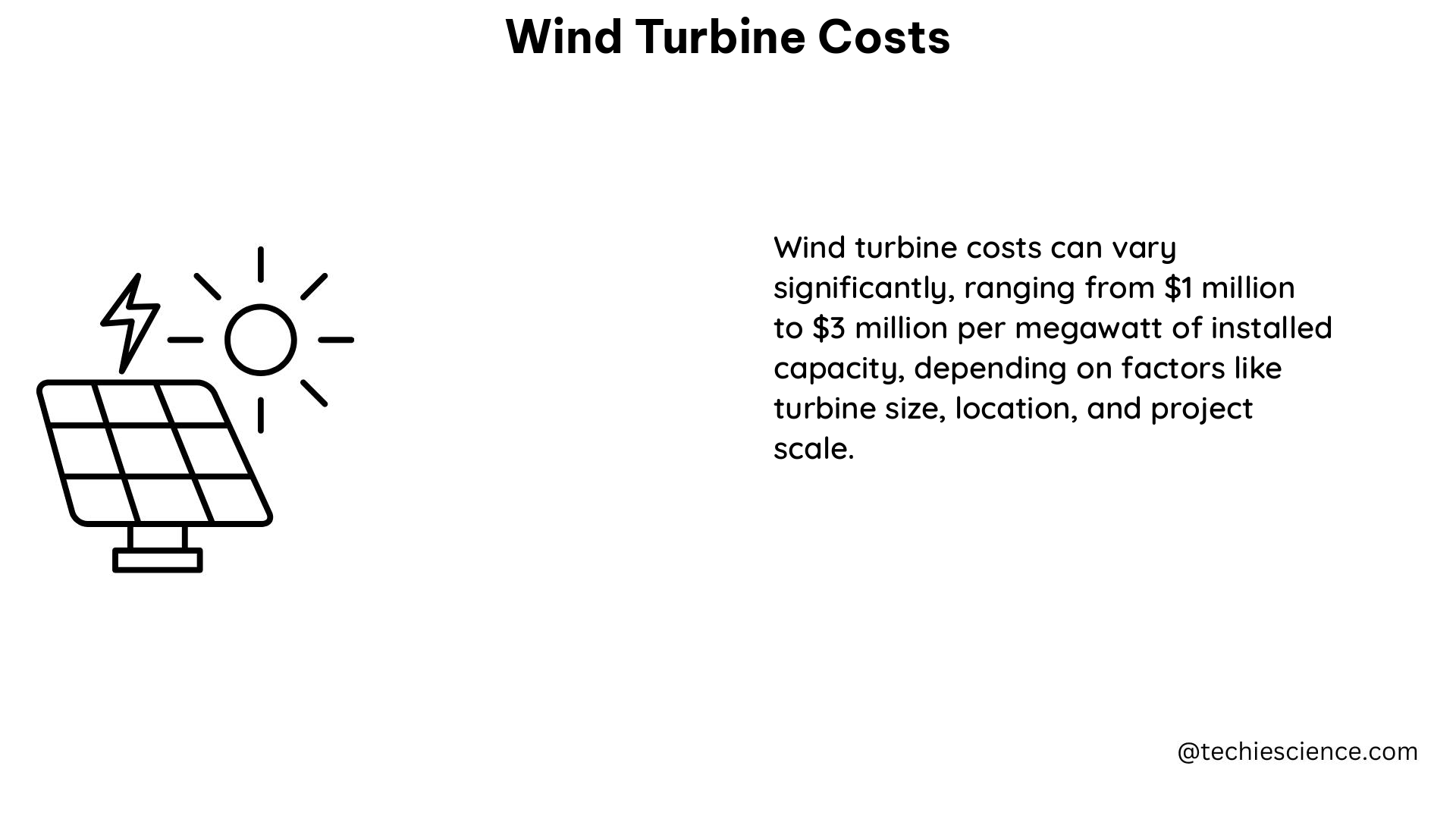Wind turbine costs are a critical factor in the widespread adoption of renewable energy solutions. This comprehensive guide delves into the intricate details of wind turbine costs, providing a wealth of technical information to help you navigate the complexities of this dynamic industry.
Breakdown of Wind Turbine Costs
Wind turbine costs can be categorized into several key components:
-
Turbine Cost: This includes the cost of materials, such as copper, fiberglass, and iron, which account for over 30% of the total cost according to a study published in the journal Renewable Energy. Labor costs, including employee productivity, also contribute significantly to the overall turbine cost.
-
Installation Cost: The cost of installing a wind turbine can vary widely depending on the site location, terrain, and accessibility. Factors such as transportation, crane rental, and foundation construction can all impact the installation expenses.
-
Operation and Maintenance (O&M) Cost: Ongoing maintenance and operational expenses, including scheduled and unscheduled maintenance, component replacements, and administrative costs, make up a significant portion of the overall wind turbine costs.
-
Financing Cost: The cost of financing the wind turbine project, including interest rates, loan terms, and other financial considerations, can have a substantial impact on the overall project economics.
Levelized Cost of Energy (LCOE) for Wind Turbines

The Levelized Cost of Energy (LCOE) is a widely used metric to evaluate the total cost of wind turbine energy generation over the lifetime of the project. According to a report by the National Renewable Energy Laboratory (NREL), the LCOE for land-based wind turbines in the United States in 2019 was between $36 and $44 per megawatt-hour (MWh), while the LCOE for offshore wind turbines was between $78 and $102 per MWh.
These LCOE values are influenced by several factors, including:
- Turbine Size and Type: Larger turbines and more advanced technologies can have a lower LCOE due to economies of scale and technological advancements.
- Site Characteristics: Factors such as wind speed, terrain, and accessibility can significantly impact the LCOE.
- Financing Conditions: Interest rates, loan terms, and other financial considerations can affect the LCOE.
- Operation and Maintenance Costs: Efficient maintenance and operational practices can help reduce the LCOE over the turbine’s lifetime.
Trends in Wind Turbine Costs
The cost of wind turbines has been decreasing over time due to advancements in technology and economies of scale. According to a study by the International Renewable Energy Agency (IRENA), the cost of wind turbines in the United States peaked in 2011 and has been declining since then.
The IRENA study found that the total cost of wind turbines in the United States in 2011 was around $2,000 per kilowatt (kW), but this cost has likely peaked and is now decreasing. This trend is driven by factors such as:
- Technological Improvements: Advancements in turbine design, materials, and manufacturing processes have led to cost reductions.
- Economies of Scale: As the wind energy industry has grown, the increased production volume has resulted in lower per-unit costs.
- Increased Competition: The growing number of wind turbine manufacturers and suppliers has fostered a more competitive market, driving down prices.
Factors Affecting Wind Turbine Costs
In addition to the LCOE, other factors can also influence the overall cost of wind turbine projects. These include:
-
Capacity Factor: The capacity factor, which represents the ratio of the actual energy output to the maximum possible energy output, can have a significant impact on the cost per unit of energy generated. Higher capacity factors can lead to lower costs per MWh.
-
Variability of Wind Energy Generation: The variability of wind energy generation can affect the cost of wind turbine projects, as it may require additional energy storage or backup generation to ensure a reliable and consistent power supply. A study published in Nature suggests that the cost of wind energy generation should include the cost of energy storage to compensate for this variability.
-
Legal and Financial Costs: Factors such as permitting, regulatory compliance, and financial structuring can also contribute to the overall cost of wind turbine projects.
Conclusion
Wind turbine costs are a complex and multifaceted topic, with numerous factors influencing the overall cost of energy generation. By understanding the breakdown of these costs, the LCOE, and the trends and factors affecting wind turbine costs, you can make informed decisions and optimize your wind energy projects for maximum efficiency and cost-effectiveness.
References
- Dao Cuong Kazemtabrizi Behzad Crabtree Christopher, “Wind turbine reliability data review and impacts on levelised cost of energy”, Renewable Energy, 2019-09-10.
- 2019 Cost of Wind Energy Review, NREL, 2019.
- Elia A. Taylor M. Ó Gallachóir B. Rogan F., “Wind turbine cost reduction: A detailed bottom-up analysis of innovation drivers”, Energy Policy, 2020-12-01.
- Cost of wind energy generation should include energy storage, Nature, 2020-02-19.
- Renewable Energy Cost Analysis: Wind Power, IRENA, 2012.

The lambdageeks.com Core SME Team is a group of experienced subject matter experts from diverse scientific and technical fields including Physics, Chemistry, Technology,Electronics & Electrical Engineering, Automotive, Mechanical Engineering. Our team collaborates to create high-quality, well-researched articles on a wide range of science and technology topics for the lambdageeks.com website.
All Our Senior SME are having more than 7 Years of experience in the respective fields . They are either Working Industry Professionals or assocaited With different Universities. Refer Our Authors Page to get to know About our Core SMEs.